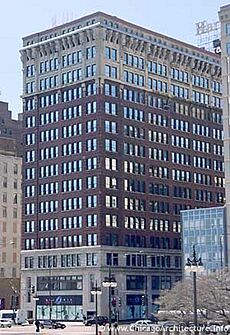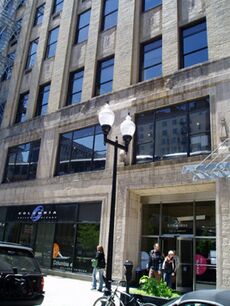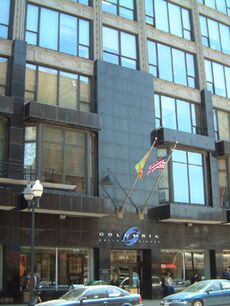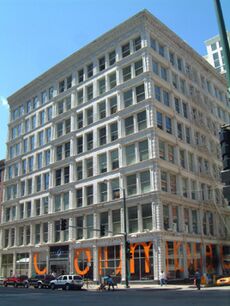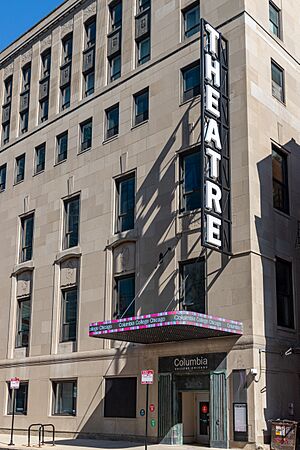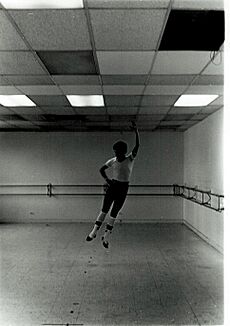Columbia College Chicago facts for kids
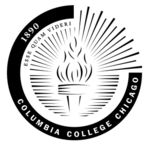
Columbia College Chicago seal
|
|
|
Former names
|
Columbia School of Oratory (1890–1904) Columbia College of Expression (1904–1928, 1928–1944) Mary A. Blood School of Speech Arts (1928) Columbia College (1944–1997) |
|---|---|
| Motto | Esse Quam Videri |
|
Motto in English
|
To be, rather than to seem |
| Type | Private art college |
| Established | 1890 |
| Endowment | $311 million (2021) |
| President | Shantay N. Bolton (July 2025) |
|
Academic staff
|
573 |
| Students | 5,570 (2024) |
| Undergraduates | 5,368 (2024) |
| Postgraduates | 148(2024) |
| Location |
,
,
60605
,
United States
41°52′26″N 87°37′30″W / 41.87391°N 87.62498°W |
| Campus | Urban |
| Mascot | Renegades |
 |
|
Columbia College Chicago is a private art college in Chicago, Illinois. It started in 1890. Today, about 5,570 students attend, studying over 60 different subjects. The college is known for its "hands-on" approach to learning about arts and media.
The college also hosts several groups. These groups focus on things like Black music, book and paper arts, and photography. It is important to know that this college is not connected to Columbia University or other colleges with "Columbia" in their name.
Contents
History of Columbia College Chicago
Columbia College Chicago began in 1890. It was first called the Columbia School of Oratory. Two women, Mary A. Blood and Ida Morey Riley, started it. They had both studied at the Monroe Conservatory of Oratory in Boston.
They wanted to open their school in Chicago. This was because the 1893 World's Columbian Exposition was coming. This big event celebrated Christopher Columbus's arrival in the Americas. Blood and Riley named their school after the exposition. They were the first co-presidents. Riley passed away in 1901, and Blood continued until 1927. They created a school for both boys and girls. They wanted to teach public speaking and build good character.
Early Years and Name Changes
From 1890 to 1904, the school was a private business. In 1904, it became an official corporation in Illinois. It also changed its name to the Columbia College of Expression. They added classes for teaching.
After Mary Blood died in 1927, George L. Scherger became president. In 1928, he signed papers to change the name to the Mary A. Blood School of Speech Arts. But just a few weeks later, the school went back to being the Columbia College of Expression.
The college then partnered with the Pestalozzi-Froebel Teachers College. This school trained students to teach kindergarten. Bertha Hofer Hegner, the president of Pestalozzi-Froebel, became the fourth president of Columbia College of Expression in 1929.
Focus on Radio and New Leadership
Bertha Hofer Hegner led the schools, but her son, Herman Hofer Hegner, took over as acting president from 1930 to 1936 due to her illness. By 1934, the college started focusing on radio broadcasting. Herman Hofer Hegner hired Norman Alexandroff, a radio expert, to create radio classes.
When Bertha Hofer Hegner retired in 1936, Herman Hofer Hegner became the official president. During his time, the college used different names for advertising. These included "Columbia College of Speech and Drama" and "Radio Institute of Columbia School of Speech and Drama." However, these names were never officially registered.
The radio program grew very popular. Alexandroff became the vice president of the college in 1937. In 1943, the college became a non-profit organization. It officially changed its name to Columbia College in 1944.
Expanding Programs and New Campuses
In the late 1940s and early 1950s, the college added more subjects. These included television, journalism, and marketing. Alexandroff also helped open new campuses. These were Columbia College Pan-Americano in Mexico City and Columbia Los Angeles in California. Both of these campuses later became independent.
Norman Alexandroff was president until he passed away in 1960. His son, Mirron (Mike) Alexandroff, became president in 1961. Mike Alexandroff had worked at the college since 1947. As president, he wanted to create a college that focused on "hands-on" learning in arts and media. He also made it easier for qualified high school graduates to attend. He worked for 30 years to build the college.
Growth and Accreditation
The college received full accreditation in 1974. This meant its programs met high standards. In 1975, with over 2,000 students, the college bought its first building. This was at 600 South Michigan Avenue. It is now called the Alexandroff Campus Center. When Alexandroff retired in 1992, the college had almost 7,000 students. It also owned or rented many buildings.
From 1992 to 2000, John B. Duff was president. On October 28, 1997, the college changed its name to Columbia College Chicago. It kept adding new programs and buying buildings in the South Loop area of Chicago. Today, the campus has almost two dozen buildings.
In 2000, Warrick L. Carter became president. Under his leadership, the college started new student events. These included Manifest, an arts festival for graduating students, and ShopColumbia, a store where students can sell their work. The college also built its first new building, the Media Production Center.
Recent Challenges and Leadership Changes
In recent years, the college has faced some challenges. Around 2011–2012, the college planned big changes to its classes and staff. This plan was called "Blueprint | Prioritization." Students and teachers were concerned about these changes. They felt that some programs might be cut. They also worried about rising tuition costs.
Many students and faculty protested these changes. They held meetings and signed petitions. News outlets like the Chicago Reader and the Chicago Tribune reported on the situation.
In May 2012, President Warrick Carter announced he would retire earlier than planned. He stepped down in 2013. On July 1, 2013, Kwang-Wu Kim became the college's 10th president. He had a doctorate in music. In February 2024, Kim announced he would step down. As of Fall 2024, Jerry Tarrer is the Interim President.
Presidents
- Mary A. Blood, 1890–1927
- Ida Morey Riley, 1890–1901
- George L. Scherger, 1927–1929
- Bertha Hofer Hegner, 1929–1936
- Herman Hofer Hegner, 1936–1944
- Norman Alexandroff, 1944–1960
- Mirron (Mike) Alexandroff, 1961–1992
- John B. Duff, 1992–2000
- Warrick L. Carter, 2000–2013
- Kwang-Wu Kim, 2013–2024
Adjunct Faculty Strike
From October 30 to December 17, 2023, some teachers at Columbia College went on strike. These teachers are called adjunct faculty. They are part-time teachers. This strike lasted 49 days, making it one of the longest of its kind in US history.
The teachers' union, CFAC, represents about 600 part-time teachers. The main reason for the strike was that many classes were planned to be cut. Most of these classes were taught by adjunct faculty. This worried both teachers and students. Students liked the small class sizes at the college. They also worried they might not find the classes they needed to graduate.
During the strike, classes taught by adjunct faculty did not meet. Eventually, other teachers filled in for these classes. On December 17, 2023, the teachers' union and the college reached an agreement. The strike officially ended on December 21. The college also told students that they would get a $500 refund for each class affected by the strike. This refund was taken off their Spring tuition bill.
Academics
Columbia College Chicago offers many different study programs. These programs are organized into eight main schools:
- The School of Audio and Music
- The School of Business and Entrepreneurship
- The School of Communication and Culture
- The School of Design
- The School of Fashion
- The School of Film and Television
- The School of Theatre and Dance
- The School of Visual Arts
Campuses
Columbia College has a unique campus in the South Loop area of Chicago. It is not like a traditional college campus with one big area. Instead, the college owns many buildings spread out in the city. These buildings are used for classes, art galleries, offices, and student housing. Many of them were built a long time ago and the college bought them as it grew.
The college also has a special program in Los Angeles, California. Students can spend five weeks there. They study film, television, music, and business at Raleigh Studios in Hollywood.
Alexandroff Campus Center
The Alexandroff Campus Center is at 600 S. Michigan Avenue. It was built in 1906–07. It was first the main office for the International Harvester Company. This building was very modern for its time. It had a steel frame, fast elevators, and electric lights. Columbia College bought it in 1975.
Today, it is the main administrative center for the college. It also has the Museum of Contemporary Photography on its first two floors. You can also find a theater, photography darkrooms, television studios, and classrooms here.
33 East Ida B Wells Drive
The building at 33 East Ida B Wells Drive was built in 1925–26. It used to be called the "Congress-Wabash Building." It had a bank, offices, and even rooms with many pool tables. Columbia College started leasing space here in 1997 and bought the building in 1999.
Now, this building holds college offices and classrooms. It is also home to the college's radio station, WCRX 88.1 FM. Departments like American Sign Language-English Interpretation, Audio Arts & Acoustics, Journalism, and Radio are located here.
623 South Wabash Avenue
The building at 623 South Wabash Avenue was built in 1895. It was first used by the Studebaker Brothers Carriage Company. Later, it was owned by the Brunswick Corporation, which made furniture for libraries and public places. Columbia College bought this building in 1983.
Today, it has classrooms, offices, science labs, and art studios. It also has two public art galleries. You can find Anchor Graphics and ShopColumbia here. ShopColumbia sells art, music, and films made by Columbia students and graduates.
624 South Michigan Avenue
This building was built in 1908. It was first home to the Chicago Musical College. Later, it was called the Blum Building. It had dance schools and clothing stores. Columbia College bought the building in 1990.
Now, it houses the college's large five-story library. It also has classrooms, offices, student lounges, and the college bookstore.
1104 South Wabash Avenue
The building at 1104 South Wabash Avenue was built in 1891. It is a very important historical building in Chicago. It was one of the first skyscrapers to be covered entirely in terra-cotta. It was built for the American Book Company, which printed books.
The building was designed to be strong enough for heavy printing presses. It was also in a good location for shipping books by train. Columbia College bought the building in 1999. Today, it houses the school's Center for Book and Paper Arts. It also has the Glass Curtain Gallery and the Conaway Multicultural Center. Most of the building is used for film and television classes and studios. There is also a modern 260-seat movie theater on the 8th floor.
Music Department
The building at 1014–16 South Michigan Avenue was built in 1912. It was first used for offices. In 1941, it became the Sherwood Conservatory of Music. A famous comedian, Phyllis Diller, studied piano here in the 1930s. Columbia College Chicago bought this building in 2007. Now, it is home to the school's music department.
Getz Theater
The Getz Theater building at 72 East 11th Street was built in 1929. It was originally owned by the Chicago Women's Club. This club held meetings, had offices, and a theater. It was a place for women to support causes like voting rights and education. Columbia College bought it in 1980. It is now the school's Theater Center. It has a renovated 400-seat theater, classrooms, and studios for film and photography.
The Dance Center
The Dance Center of Columbia College Chicago is a major dance education center in the area. Many famous dance companies have performed there.
The Dance Center building at 1306 S. Michigan Avenue was built in 1930. It was first used by a film company to show movies to independent theaters. Columbia College bought the building in 1999. After a lot of work inside, the Dance Center opened in 2000. It has modern facilities for dance education and performances. Before this, the Dance Center was in a former movie theater in the Uptown neighborhood of Chicago.
Media Production Center
The Media Production Center (MPC) is at 1600 South State Street. It was finished in 2010. This was the first new building ever built by the college. It was designed by Studio Gang Architects. The center is 35,500 square feet. It helps students in Cinema and Television Arts and Interactive Arts & Media programs. It has two soundstages for film, a motion-capture studio, digital labs, and classrooms.
Environmental Record
Columbia College Chicago cares about the environment. In 2010, the college promised to work on climate change. They have a plan to reduce their carbon footprint. They also track how much carbon dioxide they produce.
The college has a Sustainability Manager. This person helps manage green spaces on campus. They also work on recycling and composting programs.
Campus Media
Columbia College Chicago has several student-run media groups:
- The Columbia Chronicle is the college's newspaper. It has won many awards.
- Frequency TV is the college's television station.
- WCRX (88.1 FM) is the college's radio station.
Students work at these places for class credit. Some students at The Chronicle and Frequency TV can also get paid. Journalism students also write articles for Chicagotalks.org. This is a website for community news. They also create a magazine called Echo each semester.
AEMMP Records is a record label run by students. They work with artists, produce albums, and market them. Other college publications include Hair Trigger and Columbia Poetry Review.
Student Organizations
Students at Columbia College can join many clubs and groups. These groups help students get involved and learn leadership skills. Some of the main student organizations are:
- XC3ND: Columbia College Show Choir
- Producer's Guild of Columbia (PGC)
- Student Government Association (SGA)
- Student Organization Council
- Student Alumni Association
- Student Athletics Association (Renegades)
- Columbia Urban Music Association
- ReachOut
- Senior Class
- Student Programming Board
- Asian Student Organization
- Students Supporting Israel
- Hillel
- International Student Organization
- Columbia College Association of Black Journalists (CCABJ)
- Hispanic Journalists of Columbia (HJC)
- Columbia Pride (an LGBT student group)
- Latino Alliance
- Black Student Union
Student Government Association
The Student Government Association (SGA) helps students have a voice at the college. It has an executive board, a Senate, and committees. The executive board includes the president and vice presidents. The Senate has student representatives from each academic department. It also has representatives for the whole college and for students who live off campus.
The SGA Senate meetings are open to everyone. They are held on Tuesdays during the school year.
Notable alumni and faculty members
See also
- List of colleges and universities in Chicago
- Manifest (urban arts festival)


